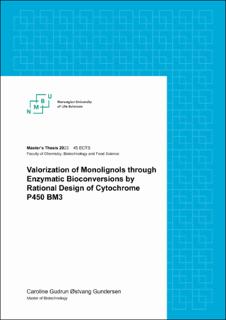| dc.description.abstract | Lignin valorization is crucial to replace fossil fuels for a more sustainable future (Karunarathna & Smith, 2020). Reductive catalysis fractionation (RCF) produces phenolic monomers, termed monolignols, that can be valorized through enzymatic bioconversions. This study’s main aim was to increase the value of three RCF monolignols: 4-propyl phenol (4-PP), 4-propyl guaiacol (4-PG), and 4-propyl syringol (4-PS), through oxyfunctionalization to value-added aromatic chemicals employing cytochrome P450 BM3 (CYPBM3) of Bacillus megaterium. Cytochrome P450 enzymes (CYPs) play critical roles in a wide range of biological processes by catalyzing diverse reactions (Munro et al., 2002) and we sought to modulate the substrate specificity and selectivity of CYPBM3 by rational design.
Three mutants, M1 (Ala184Phe), M5 (Ala74Gly), and M7 (Ala328Leu), and CYPBM3wt were expressed and purified based on initial activity towards the monolignols and expression yields. Binding to monolignols was evaluated using absorbance shift assays, activity on monolignols was assessed via NADPH depletion assay, and oxidative regioselectivity was determined through mass spectrometry (MS) analysis. Binding shift assays indicated that M5 had improved binding to the bulkier monolignols (4-PG and 4-PS), while for M1 binding was only observed with the native palmitic acid substrate. CYPBM3wt binding was observed with all substrates, while M7 did not show any binding with any substrate potentially due to the introduction of steric hindrance in the active site. M5 showed the highest NADPH consumption rate with all three monolignols. M1 showed the lowest NADPH consumption rates with 4-PP and 4-PS. M7 showed the highest NADPH consumption rate with palmitic acid, exceeding the wild type, which could be the result of the uncoupling of electron donation from the reductase domain. 4-PP was the only monolignol showing product formation by identification by MS-analysis displaying hydroxylation in the meta- and ortho positions of the benzene ring. 4-PG also showed hydroxylation but in an unknown position. 4-PS had no product formation indicating uncoupling of electrons and non-productive binding.
The results of these analyses support the use of CYPBM3 for the oxyfunctionalization of lignin-derived monolignols. Further studies will be necessary to correlate substrate binding activity or uncoupling to better conclude which candidate had better activity. LC-MS should be employed for quantification of substrate disappearance and product formation to evaluate activity and specificity. Informed by this, a combination of mutations could also be generated for improved activity. | |
